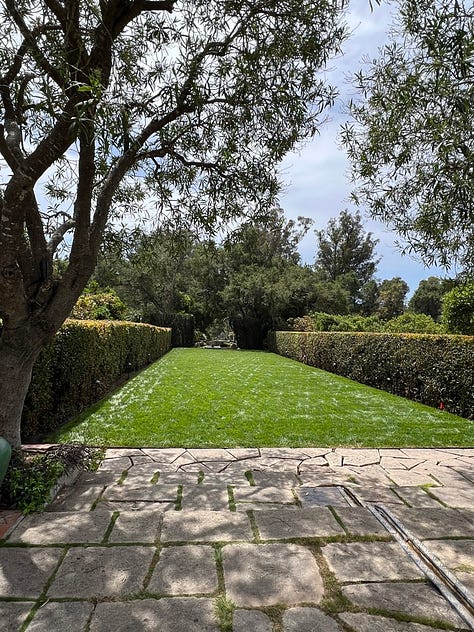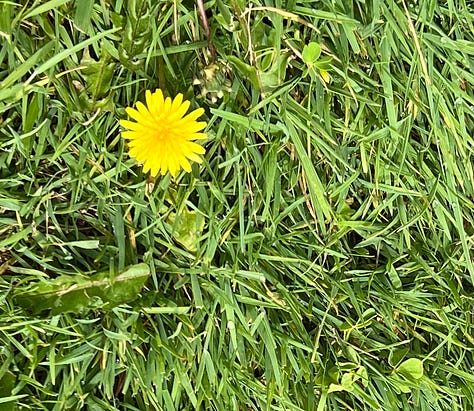


(We know the day we were born, but most of us do not know the day we will die. This love letter to my life is written on the day I've designated as my death day: the 17th of every month, and reminds me to be grateful for my joy-filled life.” —Joyce Wycoff)
Mid 1920s and money flowed freely. A mid-western industrialist and his wife wanted a summer place on the coast, wallets ready and stuffed with the boon of the war years. The best architect was hired; Europe was scoured for art. Every wall a gallery; every surface a display; almost unseeable paintings lurked between dark wooden ceiling beams; ornate hand carved doors framed doorless arches of the trendy Spanish Colonial Revival Architecture style; nine acres of grounds, spring green and lushly landscaped, created outdoor Beaux-Arts “rooms.” Elaborately detailed perfection was the standard.
A historic, living museum, as if the residents were just out for the day … but untouchable.
We walked through the empty house where once a staff of sixteen cared for the family’s needs, each art object exquisite, complete with acquisition story; silver displayed with gloved hands to show the owner’s master workmanship, cased display of ribbons noting the wife’s artistry with flowers. Perfection reigned even on the grounds with each plant carefully chosen for the designed plan or personal preference of the family.
And then, on one manicured expanse of lawn, still showing the light patterns of sodding, three dandelions broke the rules, defied the design, laughed at perfection with their bright yellow faces that launched me into a thought pool from which I emerged days later dripping with the conviction that I needed to rethink myself, my writing and the whole idea of perfection.
There is a symbiotic relationship between money and perfection.
When money can buy perfection, or the closest possible thing to it, made of the most limited and expensive materials, hand crafted by the most highly regarded artists and artisans, and often made in centuries past and now only available to the wealthiest few, those things are deemed beautiful, desirable, collectible, worthy of our passion to acquire them. Every object in that living museum had a pedigree … an artist’s name, a recognized style or school, a provenance, a story.
And, I like stories. I loved the story of one of the clocks from hundreds of years ago which only told “sort of” time. No second hand, of course, and only on time occasionally … but who would know? There were no time clocks to punch, no international standards measuring micro seconds, no Apple watches silently waiting to alert us to the next deadline.
Imagine for just a moment being disconnected from clocks.
That thought was worth the whole tour.



However, I kept thinking about those dandelions. Not beauty. Not rare. Not planted with care in exactly the right spot. Not hand pollinated from a line going back to the Pleistocene, or on any endangered list. WEEDs. Foreigners in a lawn of planned, domesticated perfection. And yet, that wild, sunny yellow that brightens the day, that shows up unannounced, without payment, requiring no special tending, asking for …. nothing, makes me wonder if Oscar Wilde had dandelions in mind when he said:
“A flower blossoms for its own joy.”
Following the crooked path of this post, I discovered that dandelions “saved” the people of Norway who are, apparently, particularly fond of coffee. When trade was blockaded by the Germans in World War I, coffee was rationed and people turned to dandelion roots as a coffee alternative. Apparently the taste was acceptable; the diuretic effects less so.
Back to perfection … definition: the condition, state, or quality of being free or as free as possible from all flaws or defects. Problem: who defines “flaws or defects”? And, why do we chase flawlessness rather than excellence or beauty or comfort or simply enough?



And, where does “good” fit in?
Does just the lack of defects (perfection) mean that it is “good” or beautiful? Much has been made of the Japanese principles of wabi sabi, honoring imperfections, and kintsugi, the art of making repairs. Maybe we should treasure the abundance of dandelions just as much as we do the rareness of an exotic orchid?
Bottomline: I live in a place that attracts wealth, however, what brought most of us here is the stunning landscape of mountains and the priceless view of the ocean horizon, the soft, gentle (and free) climate, as well as people who value fresh air and sunshine as much or maybe even more than a third-car garage. I loved seeing the gathered beauty and wealth of the living museum, but I smile when I remember the dandelions.
Perfection is a tough task master, so I think I’ll let it go and just be a dandelion.
What’s your relationship with perfection these days?
Resources:
Kintsugi: The Art of Repair by Stephanie F. Ycaza
Embracing Wabi-Sabi as your life philosophy by Deepa Thomas-Sutcliffe, MBA




Wow, what a damn good post to help get one's mind thinking and reflecting on life's stuff.
Joyce! I love this beautifully written and thought provoking assessment of the Casa del Herrero! Focusing on the dandelion, that early blossoming essential source of nectar for bees, that famine food that has for centuries provided a source of calcium and vitamin C when there was little else to eat, that “non-native weed” that disrupts the perfection of vast lawns designed to show off how much productive land a lord of a manor can afford to squander, is poignant indeed!
I’m glad you liked the lantern clock, too.
I think it must be close to that tipping point when we went from only wanting a gentle reminder of the passing of a day to obsessively measuring our time on Earth in microseconds🤣